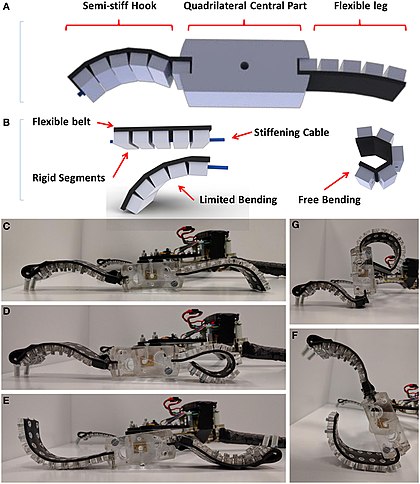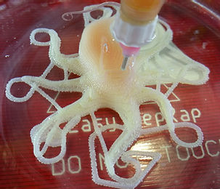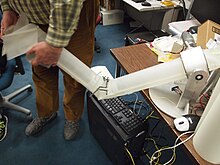SOFT ROBOTIC
 |
| Soft-legged wheel-based robot with terrestrial locomotion abilities |
Soft robotics is a subfield of robotics that issues the design, manipulate, and fabrication of robots composed of compliant substances, rather than inflexible rigid links. In comparison to inflexible-bodied robots built from metals, ceramics and tough plastics, the compliance of smooth robots can improve their protection when operating in near touch with human beings.
Types and designs
 |
| 3D printed model resembling an octopus |
The intention of gentle robotics is the design and construction of robots with physically flexible-our bodies and electronics. Sometimes softness is confined to a part of the device. For instance, inflexible-bodied robot arms can hire tender end effectors to softly take hold of and control sensitive or irregularly fashioned gadgets. Most inflexible-bodied mobile robots additionally strategically employ smooth additives, inclusive of foot pads to absorb shock or springy joints to keep/launch elastic electricity. However, the sector of soft robotics typically leans toward machines that are predominately or entirely gentle. Robots with totally tender our bodies have super potential. For one their flexibility lets in them to squeeze into places rigid bodies can't, which can show useful in disaster remedy eventualities. Soft robots also are safer for human interaction and for internal deployment interior a human frame.
Nature is usually a source of notion for soft robot design given that animals themselves are ordinarily composed of soft additives and they appear to make the most their softness for green motion in complex environments almost anywhere on Earth. Thus, smooth robots are frequently designed to appear like familiar creatures, especially totally soft organisms like octopuses. However, it is extraordinarily hard to manually layout and manipulate gentle robots given their low mechanical impedance. The very thing that makes tender robots beneficial—their flexibility and compliance—makes them hard to control. The mathematics advanced over the past centuries for designing inflexible bodies commonly fail to extend to soft robots. Thus, tender robots are generally designed in element with the help of automated design gear, which includes evolutionary algorithms, which allow a smooth robotic's shape, fabric properties, and controller to all be concurrently and robotically designed and optimized together for a given undertaking.
Bio-mimicry
Plant cells can inherently produce hydrostatic pressure due to a solute concentration gradient between the cytoplasm and outside surroundings (osmotic capability). Further, flowers can alter this attention via the movement of ions across the mobile membrane. This then changes the form and extent of the plant as it responds to this alteration in hydrostatic pressure. This stress derived form evolution is proper for soft robotics and can be emulated to create pressure adaptive substances via using fluid flow.
This principle has been leveraged within the creation of pressure structures for tender robotics. These systems are composed of tender resins and incorporate more than one fluid sacs with semi-permeable membranes. The semi-permeability permits for fluid shipping that then ends in strain era. This mixture of fluid delivery and pressure technology then results in shape and volume alternate.
Another biologically inherent shape converting mechanism is that of hygroscopic shape change. In this mechanism, plant cells react to changes in humidity. When the encircling surroundings has a high humidity, the plant cells swell, however whilst the surrounding ecosystem has a low humidity, the plant cells shrink. This extent exchange has been found in pollen grains and pine cone scales.
Similar procedures to hydraulic smooth joints also can be derived from arachnid locomotion, wherein strong and specific manage over a joint may be normally managed thru compressed hemolymph.
Manufacturing
Conventional production techniques, together with subtractive strategies like drilling and milling, are unhelpful in terms of building smooth robots as these robots have complicated shapes with deformable bodies. Therefore, extra advanced production strategies had been evolved. Those include Shape Deposition Manufacturing (SDM), the Smart Composite Microstructure (SCM) method, and three-D multimaterial printing.
SDM is a kind of fast prototyping whereby deposition and machining occur cyclically. Essentially, one deposits a cloth, machines it, embeds a favored structure, deposits a aid for stated shape, and then in addition machines the product to a final form that includes the deposited fabric and the embedded component. Embedded hardware consists of circuits, sensors, and actuators, and scientists have effectively embedded controls inside of polymeric materials to create gentle robots, which include the Stickybot and the iSprawl.
SCM is a method whereby one combines rigid bodies of carbon fiber reiniforced polymer (CFRP) with bendy polymer ligaments. The flexible polymer act as joints for the skeleton. With this method, an incorporated structure of the CFRP and polymer ligaments is created thru the usage of laser machining accompanied via lamination. This SCM system is applied inside the production of mesoscale robots because the polymer connectors function low friction alternatives to pin joints.
3D printing can now be used to print a extensive range of silicone inks the use of Robocasting also referred to as direct ink writing (DIW). This production direction lets in for a seamless production of fluidic elastomer actuators with locally described mechanical residences. It in addition allows a virtual fabrication of pneumatic silicone actuators showing programmable bioinspired architectures and motions. A huge variety of absolutely purposeful softrobots were published the usage of this method together with bending, twisting, grabbing and contracting motion. This approach avoids some of the drawbacks of conventional production routes consisting of delamination between glued components. Another additive manufacturing technique that produces shape morphing materials whose shape is photosensitive, thermally activated, or water responsive. Essentially, these polymers can mechanically alternate form upon interplay with water, mild, or heat. One such instance of a shape morphing material turned into created through using mild reactive ink-jet printing onto a polystyrene target. Additionally, shape memory polymers have been fast prototyped that incorporate special components: a skeleton and a hinge material. Upon printing, the material is heated to a temperature higher than the glass transition temperature of the hinge cloth. This allows for deformation of the hinge material, whilst no longer affecting the skeleton fabric. Further, this polymer can be usually reformed via heating.
Control methods and materials
All smooth robots require an actuation system to generate reaction forces, to allow for motion and interplay with its environment. Due to the compliant nature of those robots, soft actuation systems should be able to move without the usage of rigid substances that would act because the bones in organisms, or the metallic frame that is commonplace in inflexible robots. Nevertheless, numerous control solutions to gentle actuation hassle exist and feature discovered its use, every owning advantages and downsides. Some examples of manipulate techniques and the ideal materials are indexed beneath.
Electric field
One instance is usage of electrostatic force that can be implemented in:
* Dielectric Elastomer Actuators (DEAs) that use high-voltage electric field good way to exchange its shape (example of running DEA). These actuators can produce high forces, have excessive unique energy (W kg−1), produce huge traces (>1000%), own excessive electricity density (>3 MJ m−3), showcase self-sensing, and acquire fast actuation rates (10 ms - 1 s). However, the need for high-voltages fast turns into the restricting component inside the capacity practical programs. Additionally, those structures regularly exhibit leakage currents, tend to have electrical breakdowns (dielectric failure follows Weibull statistics consequently the chance will increase with multiplied electrode vicinity ), and require pre-pressure for the best deformation. Some of the brand new studies suggests that there are ways of overcoming a number of those hazards, as shown e.G. In Peano-HASEL actuators, which comprise liquid dielectrics and thin shell additives. These technique lowers the carried out voltage needed, as well as lets in for self-healing at some point of electrical breakdown.
Thermal
* Shape reminiscence polymers (SMPs) are clever and reconfigurable substances that serve as an notable example of thermal actuators that can be used for actuation. These substances will "keep in mind" their authentic shape and could revert to it upon temperature increase. For example, crosslinked polymers can be strained at temperatures above their glass-transition (Tg) or melting-transition (Tm) after which cooled down. When the temperature is increased again, the pressure may be launched and substances shape might be changed returned to the authentic. This of direction suggests that there's only one irreversible motion, however there have been substances confirmed to have up to 5 brief shapes . One of the best and quality recognized examples of form reminiscence polymers is a toy known as Shrinky Dinks this is product of pre-stretched polystyrene (PS) sheet which can be used to cut out shapes with a purpose to cut back extensively while heated. Actuators produced using these materials can obtain traces up to a thousand% and have proven a extensive range of strength density between <50 kJ m−3 and up to 2 MJ m−3. Definite downsides of SMPs include their slow response (>10 s) and usually low pressure generated. Examples of SMPs include polyurethane (PU), polyethylene teraphtalate (PET), polyethyleneoxide (PEO) and others.
* Shape memory alloys are behind any other manage device for smooth robotic actuation. Although made from metal, a historically rigid fabric, the springs are crafted from very thin wires and are just as compliant as other soft materials. These springs have a very excessive pressure-to-mass ratio, however stretch through the software of heat, which is inefficient power-smart.
Pressure difference
* Pneumatic artificial muscle groups, any other control method utilized in tender robots, relies on changing the strain interior a bendy tube. This manner it's going to act as a muscle, contracting and increasing, for this reason applying force to what it is connected to. Through the usage of valves, the robotic may also maintain a given shape the use of those muscle mass with out a extra strength input. However, this technique normally calls for an outside supply of compressed air to feature. Proportional Integral Derivative (PID) controller is the most normally used algorithm for pneumatic muscle tissue. The dynamic reaction of pneumatic muscle tissues can be modulated by tuning the parameters of the PID controller.
Sensor
Sensors are one of the maximum important element of robots. Without marvel, smooth robots preferably use tender sensors. Soft sensors can usually degree deformation, as a consequence inferring about the robot's position or stiffness.
Here are a few examples of soft sensors:
* Soft stretch sensors
* Soft bending sensors
* Soft pressure sensors
* Soft force sensors
These sensors rely on measures of :
* Piezoresistivity
* Polymer full of conductive particles .
* microfluidic pathways (liquid steel, ionic solution)
* Piezoelectricity .
* Capacitance .
* Magnetic fields .
* Optical loss .
* Acoustic loss.
These measurements can be then fed into a control system .
Uses and application
Surgrical assistance
Soft robots can be carried out in the scientific career, specially for invasive surgery. Soft robots may be made to help surgeries because of their shape changing houses. Shape change is important as a smooth robot should navigate round distinctive structures within the human body through adjusting its shape. This can be performed thru using fluidic actuation .
Exosuits
Soft robots can also be used for the advent of bendy exosuits, for rehabilitation of sufferers, supporting the elderly, or really enhancing the person's electricity. A crew from Harvard created an exosuit using these substances with a view to give the blessings of the extra electricity furnished via an exosuit, with out the risks that come with how inflexible materials restriction someone's natural movement. The exosuits are steel frameworks fitted with motorized muscular tissues to multiply the wearer’s electricity. Also called exoskeletons, the robotic fits’ metallic framework really mirrors the wearer’s internal skeletal structure.
The fit makes lifted items feel tons lighter, and occasionally even weightless, reducing injuries and enhancing compliance.
Collaborative robots
Traditionally, production robots were isolated from human workers because of protection issues, as a rigid robot colliding with a human could easily result in injury because of the short-paced movement of the robot. However, soft robots may want to paintings alongside human beings correctly, as in a collision the compliant nature of the robotic would save you or limit any capability damage.
Bio-mimicry
An utility of bio-mimicry thru soft robotics is in ocean or area exploration. In the search for extraterrestrial existence, scientists want to realize extra approximately extraterrestrial bodies of water, as water is the source of existence on Earth. Soft robots will be used to mimic sea creatures which could efficiently maneuver thru water. Such a project become attempted by using a crew at Cornell in 2015 below a supply via NASA’s Innovative Advanced Concepts (NIAC). The team got down to design a tender robot that might mimic a lamprey or cuttlefish in the manner it moved underwater, on the way to correctly discover the ocean beneath the ice layer of Jupiter's moon, Europa. But exploring a body of water, specially one on every other planet, comes with a completely unique set of mechanical and materials demanding situations. In 2021, scientists validated a bioinspired self-powered smooth robot for deep-sea operation which could resist the stress on the inner most part of the sea on the Mariana Trench. The robotic features synthetic muscle groups and wings out of pliable substances and electronics allotted inside its silicone frame. It could be used for deep-sea exploration and environmental monitoring. In 2021, a group from Duke University suggested a dragonfly-fashioned soft robotic, termed DraBot, with skills to observe for acidity changes, temperature fluctuations, and oil pollutants in water.
Mechanical onsideration in Design
Fatigue failure from flexing
Soft robots, especially the ones designed to imitate lifestyles, frequently have to enjoy cyclic loading with the intention to move or do the responsibilities for which they had been designed. For instance, inside the case of the lamprey- or cuttlefish-like robotic defined above, motion would require electrolyzing water and igniting gas, inflicting a fast expansion to propel the robot ahead. This repetitive and explosive growth and contraction would create an surroundings of excessive cyclic loading on the selected polymeric fabric. A robotic underwater and/or on Europa would be almost not possible to patch up or replace, so care might need to be taken to pick a material and layout that minimizes initiation and propagation of fatigue-cracks. In specific, one should pick out a material with a fatigue restriction, or a strain-amplitude frequency above which the polymer’s fatigue reaction is now not dependent on the frequency.
Brittle failure when cold
Secondly, due to the fact gentle robots are made from exceedingly compliant materials, one should bear in mind temperature results. The yield stress of a fabric tends to lower with temperature, and in polymeric substances this effect is even greater excessive. At room temperature and higher temperatures, the lengthy chains in lots of polymers can stretch and slide past every other, stopping the neighborhood concentration of pressure in a single location and making the fabric ductile. But maximum polymers undergo a ductile-to-brittle transition temperature under which there isn't enough thermal energy for the lengthy chains to respond in that ductile way, and fracture is more likely. The tendency of polymeric materials to show brittle at cooler temperatures is in fact thought to be accountable for the Space Shuttle Challenger catastrophe, and should be taken very severely, especially for gentle robots as a way to be applied in medicinal drug. A ductile-to-brittle transition temperature need not be what one would possibly recall "bloodless," and is in truth feature of the cloth itself, depending on its crystallinity, durability, aspect-organization length (within the case of polymers), and different elements.
International journals
* Soft Robotics
* Soft Robotics section of frontiers in Robotics and AI
* Science Robotics
International events
* 2018 Robosoft, first IEEE International Conference on Soft Robotics, April 24–28, 2018, Livorno, Italy
* 2017 IROS 2017 Workshop on Soft Morphological Design for Haptic Sensation, Interaction and Display, 24 September 2017, Vancouver, BC, Canada
* 2016 First Soft Robotics Challenge, April 29–30, Livorno, Italy
* 2016 Soft Robotics week, April 25–30, Livorno, Italy
* 2015 "Soft Robotics: Actuation, Integration, and Applications – Blending studies views for a soar forward in soft robotics technology" at ICRA2015, Seattle WA
* 2014 Workshop on Advances on Soft Robotics, 2014 Robotics Science an Systems (RSS) Conference, Berkeley, CA, July thirteen, 2014
* 2013 International Workshop on Soft Robotics and Morphological Computation, Monte Verità, July 14–19, 2013
* 2012 Summer School on Soft Robotics, Zurich, June 18–22, 2012
In Popular culture
 |
| Chris Atkeson's robot that inspired the creation of Baymax |
The 2014 Disney film Big Hero 6 capabilities a gentle robot, Baymax, initially designed for use in the healthcare industry. In the film, Baymax is portrayed as a huge yet unintimidating robot with an inflated vinyl exterior surrounding a mechanical skeleton. The foundation of Baymax concept comes from actual existence studies on applications of tender robotics inside the healthcare subject, along with roboticist Chris Atkeson's work at Carnegie Mellon's Robotics Institute.
The 2018 lively Sony movie Spider-Man: Into the Spider-Verse functions a woman model of the supervillain Doctor Octopus that makes use of tentacles constructed with gentle robotics to subdue her foes.
WRITTEN BY : ADRISH WAHEED
Labels: SOFT ROBOTIC

0 Comments:
Post a Comment
Subscribe to Post Comments [Atom]
<< Home